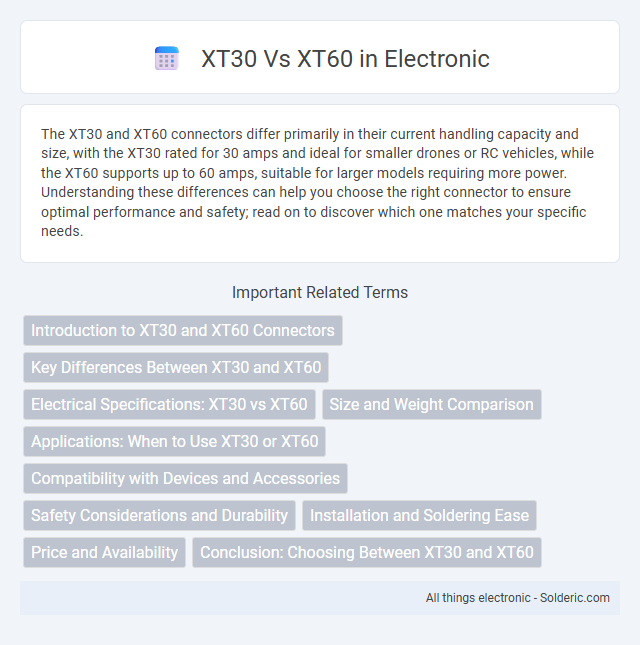The XT30 and XT60 connectors differ primarily in their current handling capacity and size, with the XT30 rated for 30 amps and ideal for smaller drones or RC vehicles, while the XT60 supports up to 60 amps, suitable for larger models requiring more power. Understanding these differences can help you choose the right connector to ensure optimal performance and safety; read on to discover which one matches your specific needs.
Comparison Table
| Feature | XT30 Connector | XT60 Connector |
|---|---|---|
| Current Rating | Up to 30A continuous | Up to 60A continuous |
| Voltage Rating | Up to 500V | Up to 500V |
| Connector Size | Small, compact | Larger, bulkier |
| Weight | Lightweight, ideal for mini drones | Heavier, suited for larger applications |
| Typical Usage | Small drones, RC vehicles under 30A | Medium to large drones, high current RC applications |
| Contact Material | Gold-plated copper pins | Gold-plated copper pins |
| Durability | Moderate, fewer mating cycles | High, more mating cycles |
| Connector Type | Male and female XT30 plugs | Male and female XT60 plugs |
Introduction to XT30 and XT60 Connectors
XT30 and XT60 connectors are widely used in the RC and drone communities for their reliability and current handling capabilities. The XT30 connector supports a continuous current rating of up to 30 amps, making it ideal for smaller batteries and lightweight applications. In contrast, the XT60 connector handles continuous currents up to 60 amps, providing a robust connection for higher power setups and larger battery packs.
Key Differences Between XT30 and XT60
XT30 connectors are designed for lower current applications, typically rated up to 30 amps, making them ideal for small drones and lightweight RC vehicles, while XT60 connectors handle higher currents up to 60 amps, suitable for larger drones and electric vehicles. The physical size and pin diameter differ significantly; XT30 connectors are smaller and more compact, allowing for tighter installations, whereas XT60 connectors are bulkier but provide a secure and robust connection for high-power setups. Both connectors feature gold-plated contacts for low resistance, but XT60's higher current rating demands thicker contacts and housing for enhanced durability and heat dissipation.
Electrical Specifications: XT30 vs XT60
XT30 connectors are rated for continuous currents up to 30 amps and peak currents around 45 amps, making them ideal for smaller RC models and lightweight drones. XT60 connectors support higher continuous currents of up to 60 amps with peaks reaching approximately 80 amps, suited for larger batteries and high-discharge applications. Choosing the right connector ensures your electrical system matches power requirements efficiently, protecting your device and maximizing performance.
Size and Weight Comparison
The XT30 connector is smaller and lighter than the XT60, measuring approximately 16mm by 8mm, making it ideal for compact applications where weight savings are critical. In contrast, the XT60 is larger at around 20mm by 12mm and heavier, designed to handle higher current loads up to 60A safely. This size and weight difference impacts device design choices, with the XT30 preferred for lightweight drones and the XT60 favored in high-power RC vehicles and larger battery packs.
Applications: When to Use XT30 or XT60
XT30 connectors are ideal for small drones, micro RC vehicles, and lightweight battery packs where low current draw (up to 30A) is sufficient. XT60 connectors suit larger drones, electric bikes, and high-performance RC models requiring higher current capacity (up to 60A) and more robust connections. Choose XT30 for compact, low-power applications and XT60 for demanding setups needing greater electrical capacity and durability.
Compatibility with Devices and Accessories
XT30 connectors are designed for smaller devices and accessories, supporting current up to 30 amps, making them ideal for lightweight drones and small RC models. XT60 connectors handle up to 60 amps and are commonly used in larger drones, electric vehicles, and high-power RC applications where higher current delivery is essential. Compatibility depends on the device's current requirements, with XT30 suited for low-to-medium power devices and XT60 preferred for high-power setups and heavy-duty accessories.
Safety Considerations and Durability
XT60 connectors offer enhanced safety features such as a more robust design with thicker gold-plated contacts that resist high current loads and reduce the risk of overheating or short circuits compared to XT30 connectors, which are suited for lower current applications. The XT60's durable nylon housing withstands higher operating temperatures and mechanical stress, ensuring reliable performance during extended use and rough handling. Safety measures like tight-fitting connectors and polarization prevent reverse polarity connections, making XT60 preferable in demanding environments where durability and safety are critical.
Installation and Soldering Ease
XT30 connectors feature smaller terminals and compact housing, making them more challenging to solder and requiring precise, delicate work compared to the significantly larger XT60 connectors. XT60 connectors offer wider, more accessible solder cups that facilitate easier installation and provide a more user-friendly experience for both beginners and professionals. The sturdier design of XT60 connectors also supports better heat dissipation during soldering, reducing the risk of damage to the connector or wires.
Price and Availability
XT30 connectors generally have a lower price point compared to XT60 connectors, making them a cost-effective choice for smaller battery applications. XT60 connectors are widely available and stockpiled by many hobby and electronics retailers due to their popularity in higher current setups. Both connectors are easily accessible online and in specialized stores, but XT60's broader use often results in more competitive pricing and diverse options.
Conclusion: Choosing Between XT30 and XT60
XT30 connectors are ideal for lightweight drones and smaller RC models due to their compact size and current rating up to 30A, ensuring optimal performance without unnecessary weight. XT60 connectors support higher current loads up to 60A, making them suitable for larger battery packs and high-power applications where reliability under heavy strain is crucial. Your choice between XT30 and XT60 should be guided by the device's power requirements and size constraints to achieve the best balance of efficiency and safety.
XT30 vs XT60 Infographic

 solderic.com
solderic.com